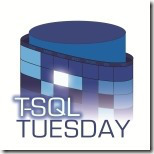This month for T-SQL Tuesday #101 Jens Vestergaard asks us to blog about the essential tools in our SQL Toolbelt.
The concept of a Central Management Server (CMS) is one I’ve been meaning to blog about for a while – just because I get the impression not a lot of people know about it or use it even though it’s been around since at least SQL 2008.
A central management server is simply one of your SQL instances on which you can register a group or groups of other instances. You can then run queries against those groups as a set, it’s a very easy way of being able to run diagnostic queries – or deploy common objects across a group.
There are other ways of performing these sorts of tasks – such as using Powershell, but with a CMS it’s really quick and easy, and all you have to know is SQL.
I’ll run through how you set one up, then give a couple of examples of using it.
Setting up your CMS
Go to the View menu in SSMS and select Registered Servers.
Then in the Registered Servers window, expand Database Engine, right-click Central Management Servers and click Register Central Management Server.

In the New Server Registration dialog select the instance you want to use as a Central Management Server.

You just need to put in the connection details – though you can also give it a friendly name in the Registered server name field.
It’s worth noting that this server isn’t going to be doing any particularly heavy lifting, it’s just going to store registrations for other servers, so there’s no need to use a dedicated instance for this.
You’ll now see this instance listed under Central Management Servers in the Registered Servers window.
You can right-click on it and either register individual servers underneath it or create one or more groups beneath which you can register servers. You can even nest groups if you want.
Here’s what it looks like after I’ve registered a few servers / groups:

And that’s it setup – told you it was easy.
Running Queries against multiple instances
This is the clever bit. I can run a query against an individual SQL instance or against a group and any sub-groups.
I want to run something against all my instances in both groups, so I right-click on My CMS Server and select New Query.

Let’s have a look at the query window as there’s some differences:

You can see the status bar at the bottom is pink, that tells me I’m connected to multiple instances via a CMS. On the bottom left you can see I’m connected to 6 out of 6, i.e. I tried to connect to 6 instances and all are successfully connected.
Now let’s run a query. Suppose I want to check MAXDOP across my instances:
SELECT name, value_in_use FROM sys.configurations WHERE name = 'max degree of parallelism';
Here’s the results:

You can see the queries against each instance have been combined into one result set and a column added for the ServerName (the friendly name I specified).
In the messages tab, we also have the output from each query:

There’s no limit to what you can do with this, as long as you can express what you want to do in T-SQL, you can execute it easily across as many instances as you want.
I use this for deploying updated versions of Ola Hallengren’s procedures across multiple instances, or the First Responder Toolkit from Brent Ozar Inc.
I use this for running checks across multiple instances like the MAXDOP one above. Earlier, I used it to check for any databases that didn’t have PAGE_VERIFY set to CHECKSUM, and then I used it to enable that across the databases where it wasn’t set.
I’ll finish with another query to change my server configurations. Having run the first one to look at MAXDOP I’ve decided I want to set it to 4 for all the servers where it’s not set:
IF (SELECT value_in_use FROM sys.configurations WHERE name = 'max degree of parallelism') = 0 BEGIN EXEC sp_configure 'show advanced options', 1; RECONFIGURE; EXEC sp_configure 'max degree of parallelism', 4; RECONFIGURE; END
Here’s the output from the messages tab:

(The really sharp eyed amongst you will notice SQL2012_Local is missing, that’s because I tested the query on that one first).
And if I run the original query again to check the settings:
SELECT name, value_in_use FROM sys.configurations WHERE name = 'max degree of parallelism';

Sorted!
Summary
Content Management Servers are an exceedingly simple way of performing admin tasks or checks against a whole bunch of SQL Instances at once.
Once you’ve set it up, anyone else with access can connect to it run queries – or add other servers and groups.
There’s still a place for Powershell, particularly in automation of tasks. But when you’re doing tasks that are a bit more ad-hoc then using a CMS is perfect.



